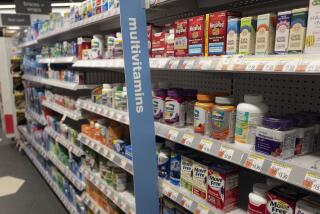Foods fortified with extra vitamins could prove costly
- Share via
These days, it’s not difficult to consume 600% of your daily recommended value of B vitamins or 2,000% of the recommended amount of vitamin C -- all before lunchtime.
Many energy bars, juices and other products are crammed with sky-high levels of vitamins. Gulp down an Odwalla Blueberry B Monster smoothie and get 360% of the daily value of four types of B vitamins. Swallow a shot of Emergen-C and you could get more than 1,600% of the daily value of vitamin C.
That’s not necessarily good. At some point, the upsides of added vitamins disappear -- and may even about-face into downsides.
When it comes to vitamin consumption, “some is good, but more is not necessarily better,” says Joan Salge Blake, a clinical associate professor of nutrition at Boston University.
Vitamin C is a case in point. Adults need between 75 and 90 milligrams a day, but many fortified juice drinks and self-proclaimed immune-boosting products, sometimes called “functional foods,” provide 10 times that amount in a single serving.
A little extra vitamin C may be helpful: Studies suggest that taking about twice the recommended amount could shorten the duration of colds. But consuming much more than that has little benefit, largely because vitamin C is water soluble, says Mary Ellen Camire, professor of food science and human nutrition at the University of Maine in Orono.
“Your body excretes the excess, and you get very expensive urine,” Camire says. Not to mention cramps, nausea and diarrhea -- the other potential side effects of taking several grams of vitamin C or more in a single day.
The B vitamins are another good example. Overconsumption risks depend on the B vitamin in question: Consuming 500 milligrams a day or more of B6 (adults need 1.3 to 1.7 milligrams) can cause reversible nerve damage, whereas several hundred times the recommended amount of B12 (which is 2.4 micrograms) is harmless.
But it’s not clear why you would want more than the daily value anyway. Contrary to claims made by some supplement promoters, vitamin B6 hasn’t been found to alleviate the symptoms of depression or premenstrual syndrome, and vitamin B12 hasn’t been found to prevent heart disease, improve mental acuity or boost exercise performance.
Vitamin A, meanwhile, dissolves in fat, so any excess beyond what the body needs can get stored in tissue. For that reason, consuming mile-high levels of these vitamins poses its own risks.
As high levels of the vitamin build up, they can cause nausea and vomiting, blurry vision, lack of coordination and, eventually, liver damage.
In 2006, doctors at the Mayo Clinic Arizona, in Phoenix, reported in the journal Liver Transplantation the case of a 60-year-old man with rashes, sore muscles, hair loss and chronic liver disease -- the result of taking 20 to 100 times the recommended value of vitamin A daily for 10 months. A similar case was reported in the journal Annals of Hepatology that same year by doctors in Buenos Aires who had treated a young man who had been taking high levels of vitamin A in order to build muscle.
Such cases are, admittedly, rare. But the trend toward vitamin supplementation combined with the popularity of so-called functional foods has led to some concern among nutritionists and public health experts, Camire says. In a survey of 1,200 teens and adults published in the Canadian Journal of Dietary Practice and Research last year, respondents reported that they would increase their consumption of certain foods -- including snacks and juices -- if they were fortified with extra vitamins. (The survey was conducted by the Dairy Farmers of Canada, an industry group.)
The fear of overconsumption may be there, but the evidence of harm is so far lacking, Camire adds. To date there’s no evidence that vitamin toxicity has become more common as a result of increased consumption of heavily fortified foods.
In a study published in the journal Food and Nutrition Research in October, researchers in nine European countries pooled data on consumption of food, fortified foods and supplements to determine how frequently people were meeting or exceeding the tolerable upper limit of vitamins and minerals -- the limit is the level at which toxic effects, such as vomiting or lack of coordination, can occur. Even among people who consumed high amounts of vitamins, consumption was well below the upper limit.
“With most vitamins, the upper limit is so high that it’s hard to hit,” says Roger Clemens, a professor at the USC School of Pharmacy whose research has focused on functional foods.
The risk is, at least theoretically, most pronounced in people who consume both supplements and fortified foods, he says.
Eating a variety of foods, functional or not, diminishes any overconsumption risk. “If you have diversity in your diet, it’s very remote that you would exceed the safe upper limit” for any vitamin, Clemens says.
Camire has another piece of advice: If you’re worried you might be getting too many vitamins, switch over to unfortified juices and snacks.
“In most cases, you’re not going to get too many vitamins from natural foods,” she says.
